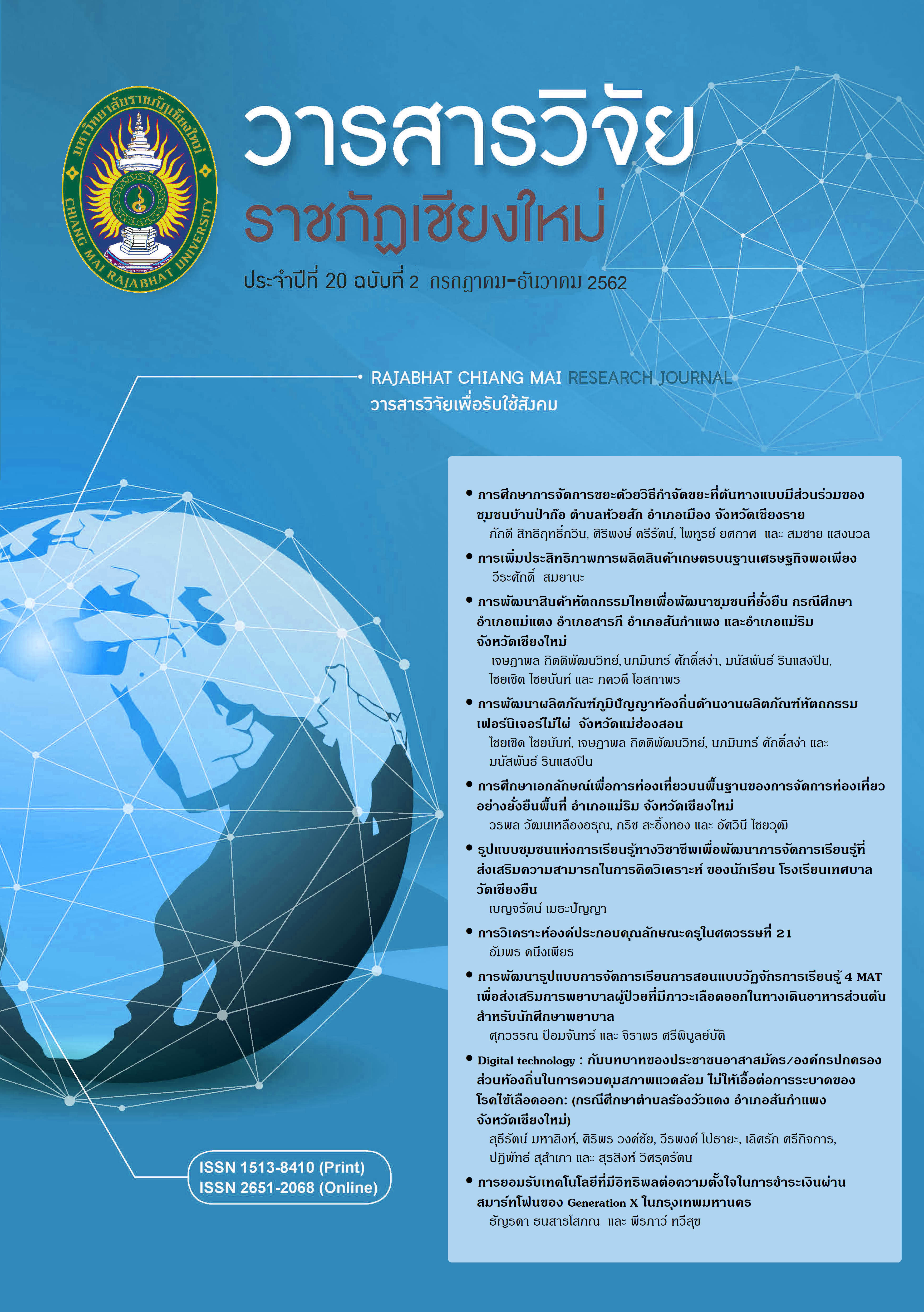Study for Uniqueness in Tourism Base on Sustainable Tourism Management, Mae Rim District Chiang Mai Province
DOI:
https://doi.org/10.14456/rcmrj.2019.217621Keywords:
Uniqueness of sustainable tourism, Sustainable tourism management, The host community, Mae Rim districtAbstract
This basic research has 3 objectives: 1) To study the settings of Mae Rim District, Chiang Mai Province 2) To promote the community involvement and to create the community strength in sustainable tourism development 3) To set the tourism uniqueness based on sustainable tourism in the areas of Mae Rim District, Chiang Mai Province. The sustainable tourism management plans were based on qualitative research through non-participation observation, focus groups and community workshops. The data analysis was presented in the Descriptive Analysis and the related literature review. The local government’s strategic plan of 11 Districts as indicated, have focused on the well beings and the economy in each area, but only six areas have focused on strategic tourism plan : Mae Rim Sub-District, Rim Nua Sub-District, Mae Ram Sub-District, Pong Yaeng Municipality Office, Mae Sa Municipality Office and Don Kaew Municipality Office. In these areas, the community workshops and the community participation were used to develop the tourism sites, particularly Pong Yaeng Municipality Office, Don Kaew Municipality Office, Baan Wang Pong, Moo 6, Mhuang Kaew Municipality Office and Baan Tha Khrai, Moo 2, Mae Sa Municipality Office.
In conclusion, the tourism uniqueness in Mae Rim District based on sustainable tourism has the key factors in economy, social cultural and environment bases which are the key factors of sustainable tourism. The study also proposed the following main factors in tourism area development:
The 1st factor is the local people. They should have knowledge and understanding in tourism development and the benefits of tourism by developing their skills, knowledge and ability in tourism activities continuously. The focus should be on systematic management, good hospitality and service, situational management and involvement in community conservation promoting tourism in all the aspects.
The 2nd factor is the way of life. This means the conservation of historical uniqueness, the changes from the original agriculture ways to organic farming, career changes to the producers of various local products and the main and unique culture and tradition conservation.
The 3rd factor is the environment conservation. Promoting to decrease the home wastes can lead to be the best environment conservation model
The 4th factor is the Sufficiency Economy Concept. Every home plants home-grown vegetables for own consumption and for serving tourists in homestays and in local food shops. This can help the community to save the expenses and to earn more extra incomes.
Downloads
References
กรมการพัฒนาชุมชน. (2561). ชุมชนท่องเที่ยว OTOP นวัตวิถี ภายใต้โครงการไทยนิยม ยั่งยืน. สืบค้นจาก https://rdic.cdd.go.th/wp-content/uploads/sites/154/2018/10/OTOPนวัตวิถี.pdf
ชูสิทธิ์ ชูชาติ และ ถนัด บุญชัย. (2561). การเสด็จประพาสต้นสู่การพัฒนาอย่างยั่งยืน. เชียงใหม่ : มหาวิทยาลัยราชภัฏเชียงใหม่
ทรัสต์เพื่อการลงทุนในอสังหาริมทรัพย์และสิทธิการเช่าดุสิตธานี. (2560). ภาพรวมของภาวะอุตสาหกรรมของ
ธุรกิจการจัดหาผลประโยชน์จากอสังหาริมทรัพย์. สืบค้นจาก : https://market.sec.or.th/public/ipos/IPOSGetFile.aspx?TransID=251523&TransFileSeq=44
บุญเลิศ จิตตั้งวัฒนา. (2548). การพัฒนาการท่องเที่ยวแบบยั่งยืน. กรุงเทพฯ : เพรส แอนด์ ดีไซน์.
ระบบฐานข้อมูลสารสนเทศ จังหวัดเชียงใหม่. (2560). ข้อมูลและแผนพัฒนา : โครงการพัฒนาระบบฐานข้อมูลทรัพยากรป่าไม้ อำเภอแม่ริม. สืบค้นจาก : https://gis.chiangmai.go.th/index.php?name=infobase&themeID=7&pid=54&District_ID=7. 2553
ระบบสถิติทางการทะเบียน. (2560). จำนวนประชากรแยกรายอายุ . สืบค้นจาก :
https://stat.dopa.go.th/stat/statnew/upstat_age_disp.php.
ศิริรักษ์ ยาวิราช, ชรัญญา สุวรรณเสรีรักษ์, เก็จวลี ศรีจันทร, ศุภวัชร์ อินฝาง และรุจิรา สุขมณี. (2561). แนวทางการพัฒนาส่วนประสมทางการตลาดบริการ ตามความต้องการของนักท่องเที่ยว : กรณีศึกษาหมู่บ้านแม่สายป่าเมี่ยง ตำบลโหล่งขอด อำเภอพร้าว จังหวัดเชียงใหม่. วารสารวิจัยราชภัฏเชียงใหม่, 19(2), 126-135.
อำเภอแม่ริม. (2560). ประวัติความเป็นมา. สืบค้นจาก : https://www.nfccmi.or.th/assets/uploads/pages_img/b5b54-จังหวัดเชียงใหม่.pdf
Downloads
Published
How to Cite
Issue
Section
License
1. Articles, information, content, images, etc published in the “Community and Social Development Journal” are copyrighted by the Community and Social Development Journal, Chiang Mai Rajabhat University. In order to properly distribute the articles through print and electronic media, the authors still hold the copyright for the published articles under the Creative Commons Attribution (CC BY) license, which allows the re-distribution of the articles in other sources. References must be made to the articles in the journal. The authors are responsible for requesting permission to reproduce copyrighted content from other sources.
2. The content of the articles appearing in the journal is the direct responsibility of the article authors. The editorial board of the journal does not necessarily agree with or share any responsibility.














